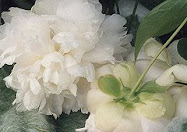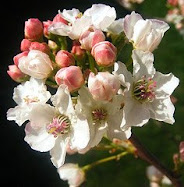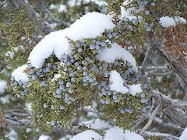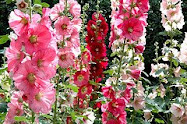
The first 2009 plant catalogue,* from Bluestone Perennials, arrived in the mail, a most welcome sight in these deep winter days with its jaunty cover photo of a fling of apricot helenium flowers. It seemed worth spending maybe a quick half-hour browse, just to see what plants might jump up from the page as potentials for next spring (because spring will return in just a few months, even though it feels so very far away and unlikely with the garden hibernating beneath several feet of snow).
Two or three hours later, having read the tantalizing catalogue from cover to cover, a selection of a very restrained half-dozen specimens were flagged as definite must-haves for the garden. Already fairly flush with spring and early summer flowering plants, the garden still yearns for more summer into autumn bloomers. This consideration, along with seeking newcomers to introduce fresh personalities to the garden, and also to offer bloom time that lasts for more than just a week, guided the specimen choices.
Rudbeckias produce daisy and sparkler-style flowers from summer until frost knocks them down. Black-Eyed Susans are a common rudbeckia. Their color scheme ranges from butter yellow to sherry red, and some types – Henry Eiler, and maxima, and prairie sun – reach from three to even five feet in height. These gangly rudbeckias could really fill out and punctuate the back of a border during autumn's low-flowering stint. Prairie sun, labeled a “gold medal winner,” won a place on the order list for its limey green center surrounded by petals shading from soft tangerine to pale yellow at their tips. The catalogue promises rudbeckias are robust, self-seeding and can last for many years. What more could be asked?
Next on the list of desirables comes a Max Vogel anemone, with a flower that resembles a double-petalled cosmo, and colors a cotton-candy pink around a hot-orange center. This one also flowers continuously late summer through the fall, and grows two-to-three feet tall. When a plant is tall, bushy and full-flowered enough to be seen and enjoyed from across the yard or through the windows from indoors, it really broadens the garden vista and charms.
Another perennial that will stand up tall for itself with a two-foot, columnar flower stalk is the cherry blossom delphinium. The creamy pink flower got this one on the list, it's just what the blue and white delphiniums in the border under the front window need to nicely enlarge their color scheme. I'm a sucker for the pretty, frilly delphinium, even though it takes a little extra watering to keep it going in dry summers. Delphiniums love the sun but really don't like to get parched. If the flower stalk is cut back close to the ground when the bloom is finished, it will re-flower very reliably, though usually with a smaller flower head.
In the smaller, edging category, a catananche (love plant) caerulea teal blue and a feathery white look like winners. Late June through August flowering, these grow to about a foot and a half, are reported to have “many flowers above interesting silver-green foliage,” and have a flower similar in appearance to a bachelor button, pointy dense petals with a contrasting-color center. These girls like sun and well-drained soil, so they could really take to the front edge of the sunny, sandy garden, raising smiles to passersby on the sidewalk.
A surprising, fairly unusual find in the catalogue were special-species chrysanthemums, such as spoon, quilled, and football mums, which previously have been come across only in specialty mum catalogues. Mums are the queens of autumn tints and show in the garden, long-lasting and pretty hardy if they are mulched in cold-climate winters. If the foliage is pinched back up until the first of July, and no later, mums create lots of flower buds. The football mum flowerhead spreads round and wide, with inward-curving petals, in a big sphere more like a giant softball than a pigskin oval. Here are the colors offered in the football mums – amber, coral, French vanilla, russet, buff pink and light bronze. I mean, how could anyone resist trying some of these Reubenesque beauties?
Last but not least, the pinky-winky, perpetual-flowering hydrangea is darn near irresistible. The shrub can reach six feet in height, the twelve-inch, cone-shaped flowers stand upright and segue from white to pink to dusky rose, and can be cut and hung to dry for arrangements that will last until the next year's blooms appear. Hydrangeas also like regular watering in droughty spells, but doesn't summer-long flowering make it worth a little extra hose time?
All the above entries except the delphiniums will be brand new characters on the scene. At present, the standard, well-known cottage-garden plants such as hollyhock, poppy, daisy, lupine, peony, rose and so forth, are already well-represented in the garden. Now I'm looking to incorporate adventure and new names, species that may give innovation and diversity, that can be tried out to see if they will like and thrive in this northwest Michigan location, and perhaps enlarge the collection of favorites and strong performers.
Catalogues are excellent for searching out such new, untried plants. They also make useful reference tomes, to be consulted for photos and behavioral traits when one comes upon the name of an intriguing, heretofore unknown plant. With information from a catalogue, the gardener can seek out wanted specimens at local nurseries, or request that they be ordered by the neighborhood garden center. The catalogue arms us with our preferred marching orders for the surely coming next spring, even if we choose to employ the information only to shop locally for plants we can see, touch and thereby verify their strength, appearance and good health. In a snowbound Michigan January, plant and seed catalogues make for a full afternoon's enlightening, exciting reading.
*( Yep, thank you, Mr. Busybody Spellcheck, I do realize that “catalogue” isn't spelled this way any longer. However, it's still spelled this way by the gardener, as it looks better with all its letters intact, and I do not cotton to the new, efficiency-inspired practice of lopping off perfectly good letters from the words in which they've always resided. Nope, that's not my favourite thing.)









No comments:
Post a Comment